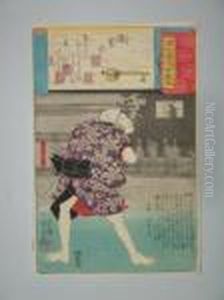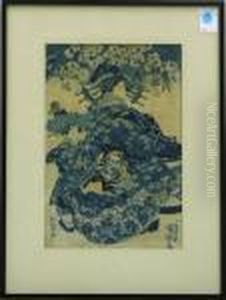Ichiyusai Kuniyoshi Paintings
Ichiyusai Kuniyoshi was a significant figure in the Ukiyo-e genre of Japanese woodblock prints, particularly known for his depictions of historical and mythical figures, landscapes, and warriors. Born in Edo (now Tokyo) in 1797, Kuniyoshi was the son of a silk-dyer and showed early promise in the arts. At the age of 14, he became an apprentice to one of the great masters of Ukiyo-e, Utagawa Toyokuni I, and spent his formative years learning the craft of woodblock printing.
As Kuniyoshi grew older and developed his own style, he began to distinguish himself from other artists of his time with his unique and often vibrant portrayals of subjects. One of the turning points in his career came with the series '108 Heroes of the Popular Suikoden All Told' (1827-1830), which depicted scenes from the classic Chinese novel 'Shui Hu Zhuan' (known as 'Suikoden' in Japanese). The series was a hit and helped him to gain fame and a following.
Kuniyoshi was known for his innovative techniques and for pushing the boundaries of the woodblock print medium. He frequently experimented with unusual compositions, and his prints are characterized by dynamic action and rich detail. At times, his work reflected the political climate of Japan, such as the strict government censorship laws of the time, which he often circumvented through subtle means in his artwork.
Apart from historical and mythical narratives, Kuniyoshi also produced a wide range of other works, including landscapes, actor portraits, and images of beautiful women (bijin-ga). His landscapes were influenced by the work of contemporary artists like Katsushika Hokusai and were part of the movement that influenced the Japonisme trend in Europe.
Kuniyoshi's later years were marked by financial difficulties and declining health, but he continued to work until his death in 1861. His legacy lived on through his students, and his influence can be seen in the work of subsequent generations of artists. Kuniyoshi's prints remain highly regarded for their artistic quality and historical value, and they continue to be appreciated by collectors and art enthusiasts around the world.



